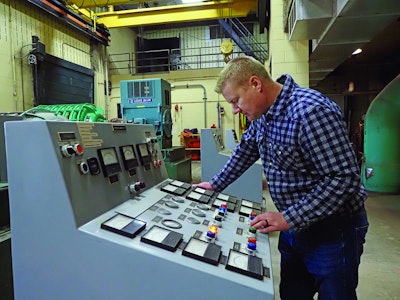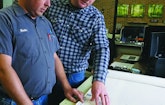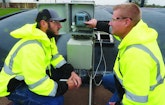
The team at the Albert Lea Wastewater Treatment Plant includes, from left, Parker Hanna, wastewater operator; Dustin White, wastewater foreman; Nick Finholdt, wastewater maintenance/operator; Brandon Huston, superintendent; Cavit Wobschall, wastewater operator; Matt Larson, lab technician; and Matt Jensen and Travis Rauenhorst, wastewater operators.
Brandon Huston looks at wastewater treatment as more than a career. It’s fair to say he considers it a calling.
“I always had a desire to help the environment,” says Huston, wastewater treatment plant superintendent in Albert Lea in Southern Minnesota. “I feel like we’re actually doing something good for humankind. We’re solving diseases. We’re removing pollutants from the rivers. We’re working with industries and benefiting them as well.”
Huston has been with Albert Lea (population 18,000) since he started as an intern 25 years ago. After four years in his current position he was named the 2023 Outstanding Class A Operator of the Year by the Minnesota Wastewater Operator Association.
Huston is proud of steps he and his nine-member team have taken to improve the treatment plant; he looks forward to a major upgrade expected to unfold over the next several years. He reports to Steven Jahnke, director of public works and city engineer.
The wastewater treatment plant team includes Dustin White, foreman; Matthew Larson, lab technician; and operators Matthew Jensen, Doug Yotter, Travis Rauenhorst (also backup lab technician), Cavit Wobschall, Parker Hanna and Nick Finholdt.
FARM CONNECTIONS
Huston grew up on a farm half an hour west of the Albert Lea plant, where he took advantage of an internship program after high school. “I always wanted to work in testing water or work for the DNR testing rivers,” he says. “The internship opened up. I fell in love with the industry and have been with it ever since.”
He was hired as a part-time operator the day he graduated from Riverland Community College with an associate degree in environmental technology. He then worked eight years as a full-time operator and 10 years as a lab technician (the last two also as foreman) before being promoted to plant superintendent. He holds a Class A (highest) Wastewater Operator license.
Huston’s farm background gave him insights toward finding qualified people for his team, which over the years lost experienced operators to retirement: “We look for people who have mechanical aptitude and some type of mechanical experience, and we train them from within.
“Maybe they’re a farm kid, or they’re in some type of maintenance program within their facility. Basically we’re looking at, ‘What have they built?’ ‘What have they taken apart?’” Job openings are posted on Indeed, on the city website, in the local newspaper and with wastewater professional associations.
New hires are first trained in safety. “I want them to understand how the plant all works,” says Huston. “I send them out with one of our seasoned operators or our foreman. They need to know where the lockout/tagout equipment is, where all the PPE is stored.”
For basic wastewater training, Albert Lea provides online courses through Suncoast Learning and Sacramento State University. New operators can study during the year they spend gaining the hands-on experience required for a Class D license. Before sitting for the exam, they take a preparatory course offered by the Minnesota Pollution Control Agency at various locations.
EMPHASIS ON LICENSING
Huston insists that all plant team members become licensed. “We used to have separate maintenance and operator positions,” he says. “When I took over we only had four licensed operators. My goal is to have everybody licensed so they can be put on for weekends and take the workload off of just four individuals.
“It also takes away issues with, ‘That’s not my job.’ Everybody does maintenance. There’s no complaining. I want our guys to feel good about their jobs and know they have accreditation for what they’re doing.” Team members receive a pay boost for each license level they attain.
As a result, says Huston, “We have a wonderful crew. A lot of my success is based off what they’ve done for us. They’re awesome at what they do. They have a good work ethic. When they do well, I do well.
“We have morning meetings every day for 10-15 minutes, and I make sure everybody communicates. We go over a weekly synopsis of all the things we’re likely to see happen, and then each individual operator is assigned tasks. And I get updates on things happening in the plant that they say need to be fixed.
“My goal is first and foremost to fix anything that’s a safety issue. If we find issues with gas, or electrical, or pinch points, or you name it, we try to resolve those right away.” A company called SafeAssure provides a variety of safety training and each year performs a simulated OSHA inspection that ends with a list of recommendations.
CONSISTENT COMPLIANCE
The Albert Lea plant (9.85 mgd design, 3.3 mgd average) in most years receives one of the Facility Operational Awards presented annually by the MPCA for permit compliance. Influent is screened before it enters the force main that delivers it to the plant. The flow first passes through a Hycor Waterlink grit classifier (Parkson Corporation) and then primary clarifiers using Eimco drives (Ovivo).
The activated sludge process (Hoffman blowers) includes nitrification and clarification (Ovivo drives) followed by sand polishing filters (also Ovivo). After UV disinfection (Fischer-Porter), the final effluent discharges to the Shell Rock River.
Waste activated sludge is thickened by dissolved air flotation (Ovivo) before being sent to the anaerobic digesters (Ovivo). The digested material passes through rotary drum thickeners (Vulcan) before storage for application to cropland close to the plant. The city has 1,186 acres permitted, 81% of it owned by one farmer. A contractor pumps the liquid biosolids from a storage lagoon by way of a 6-inch hose directly to the fields for injection into the soil.
UPGRADES ON THE WAY
Huston looks forward to a series of upgrades to cost about $80 million spread over several years. The improvements will include a new pretreatment building a vortex grit removal system and grit classifier, biological and chemical phosphorus removal to meet an expected effluent phosphorus limit, and a biosolids dryer to replace anaerobic digestion.
“We are one of very few cities in the state that don’t have a phosphorus limit,” says Huston. “We’ve been monitor-only for decades, partly because the Shell Rock River is not technically a Minnesota watershed. All that water flows into Iowa.”
Anaerobic digestion will be eliminated because with a substantial reduction in BOD from food processors, biogas production has declined. The two existing 35 kW microturbines used for cogeneration are aging, and the electricity they feed to the plant covers only about 10% of the total power demand.
“Our engineers determined that it’s much cheaper to abandon anaerobic digestion because of code issues, electrical issues and worn-out equipment,” Huston says. “On paper, anaerobic digestion looks wonderful. But this plant was designed for 22,000 pounds of BOD per day coming in, and we’ve been averaging 9,000 to 10,000 pounds. That’s just not enough.”
Plans call for the biosolids to be dewatered to about 20% solids on a screw press and then fed to a natural-gas-fueled thermal dryer producing material at 90-96% solids. “We’re trying to future-proof ourselves,” Huston says. “We’re trying to set it up so we could go to a new process after a dryer, like pyrolysis.” That or some other high-temperature process would destroy PFAS, for which Albert Lea biosolids so far have not been tested.
The upgrades will also include an additional secondary clarifier for settling of phosphorus after alum addition, new disc filters and UV disinfection, a septage receiving station, new offices and new electrical switchgear.
DILIGENT MAINTENANCE
The existing plant is built for reliability and ease of maintenance. All major equipment has redundancy so that a pump or valve can be taken out of service for repair without interrupting treatment. Team members can track equipment operating hours on the Wonderware SCADA system (AVEVA) and perform planned maintenance on schedule. Housekeeping is a priority. Operators mow some 30 acres of grass, prune trees and trim weeds. The grass is allowed to go natural with clover, dandelions and other flowering plants to provide pollinator habitat.
Inside the facility, operators regularly hose or brush the clarifiers weirs; they pressure wash the concrete on the clarifiers and aeration basins. A city street sweeper cleans the roads within the complex. The building windows are kept clean, the interiors walls washed and painted. Old exterior lights are being replaced with LEDs.
SOURCES OF PRIDE
“I want our plant to look like a park,” says Huston. “It’s one of the most expensive properties the city owns. I want to show the public and the city management that we’re caring for their investment.”
Huston takes pride in improvements made on his watch. Leachate accepted from an Iowa landfill generates some $500,000 a year in revenue and does not upset the process. Training for team members has helped elevate plant performance: “Some people say, ‘What if you train all your guys and they leave?’ My mentality is, ‘What if I don’t train them and they stay?’ My goal is to make sure our team members can run the plant in my absence if they need to.”
A certified lab has been a valuable asset: “We’ve been able to maintain certification not only for MPCA but also for the Department of Health in testing for coliform in the city’s drinking water. With an accredited lab we can have the data extremely fast instead of waiting for a third-party lab to get back to us. It makes plant control so much easier.”
Huston is also proud to be part of an industry that is advancing in sophistication. “They’ve solved a lot of the world’s problems with pollution, and now they’re fine tuning it and dialing in,” he says. “In past decades we were looking at PCBs and heavy metals. Now we’re looking at future concerns with PFAS.”
Albert Lea is among about 30 cities working with the University of Minnesota on wastewater surveillance for COVID-19. “You can actually determine when COVID is going to hit a community before the cases start appearing,” Huston says. “Our bodies excrete RNA from the SARS-CoV-2 virus days before the symptoms show up.”
Huston’s brand of leadership is sure to help keep Albert Lea’s clean-water facilities on the cutting edge.









